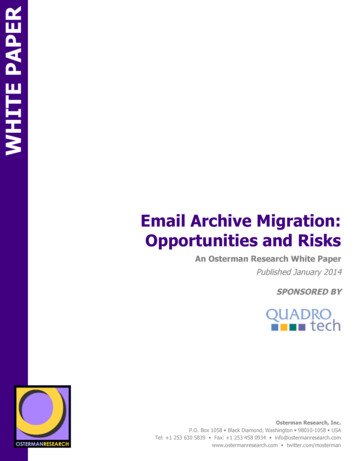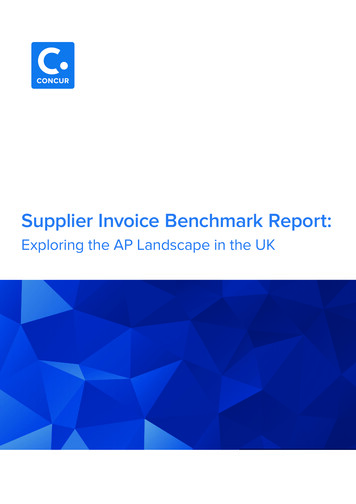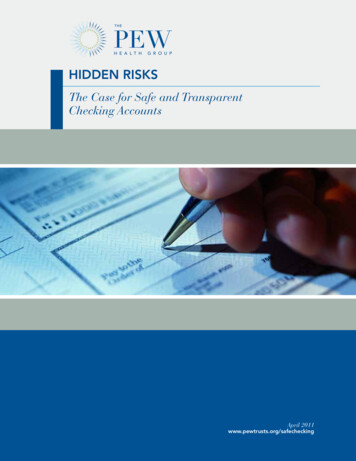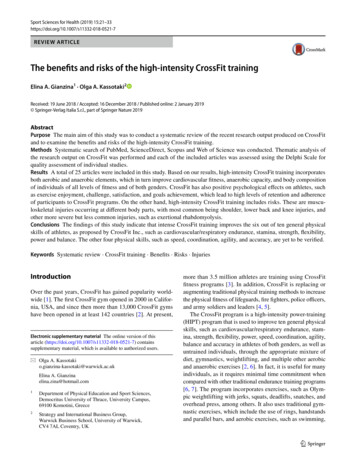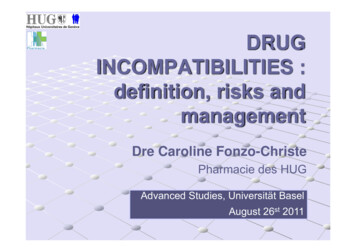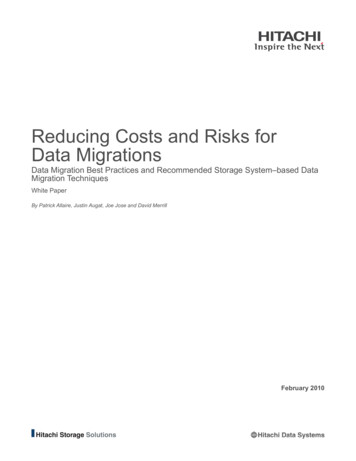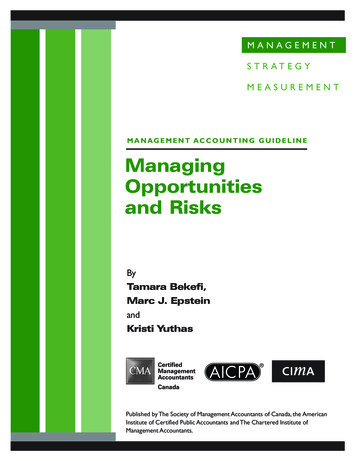
Transcription
MANAGEMENTS T R AT E G YMEASUREMENTM A N AG E M E N T AC C O U N T I N G G U I D E L I N EManagingOpportunitiesand RisksByTamara Bekefi,Marc J. EpsteinandKristi YuthasPublished by The Society of Management Accountants of Canada, the AmericanInstitute of Certified Public Accountants and The Chartered Institute ofManagement Accountants.
N OT I C E TO R E A D E R SThe material contained in the Management Accounting Guideline Managing Opportunities and Risks is designed to provideillustrative information with respect to the subject matter covered. It does not establish standards or preferred practices.Thismaterial has not been considered or acted upon by any senior or technical committees or the board of directors of either theAICPA, CIMA or The Society of Management Accountants of Canada and does not represent an official opinion or position ofeither the AICPA, CIMA or The Society of Management Accountants of Canada.Copyright 2008 by The Society of Management Accountants of Canada (CMA Canada), the American Institute of CertifiedPublic Accountants, Inc. (AICPA) and The Chartered Institute of Management Accountants (CIMA). All Rights Reserved.No part of this publication may be reproduced, stored in a retrieval system or transmitted, in any form or by any means, withoutthe prior written consent of the publisher or a licence from The Canadian Copyright Licensing Agency (Access Copyright).For an Access Copyright Licence, visit www.accesscopyright.ca or call toll free to 1 800 893 5777.ISBN: 1-55302-212-2
MANAGEMENTM A N AG I N G O P P O RT U N I T I E S A N D R I S K SINTRODUCTIONRisk taking, the engine driving business,is vital to companies seeking marketsuccess. Risks are, however, often thoughtof only as hazards, despite the fact thatthey can present significant opportunitiesand possibilities for organizationalinnovation and new competitive advantageleading to short- and long-term profitability. In fact, risk and opportunity are aduality—like two sides to the same coin.Managing hazardous risk has beenincreasingly recognized as a criticalbusiness issue prompted by events asdiverse as the financial debacles ofcompanies like Enron,Worldcom, andParmalat, the terrorist events ofSeptember 11, 2001, and the hurricanedisaster of Katrina in 2005. CMA Canada,the AICPA, and CIMA have respondedwith four Guidelines that address thisissue:a) “Identifying, Measuring, and ManagingOrganizational Risks for ImprovedPerformance”;b) “The Reporting of OrganizationalRisks for Internal and ExternalDecision Making”;c) “Integrating Social and Political Riskinto Management Decision Making”;andd) “Business Continuity Management”.Though these four ManagementAccounting Guidelines on risk provideexcellent coverage of many of the mostCONTENTSEXECUTIVE SUMMARYPageINTRODUCTION3THE ROLE OFFINANCIAL PROFESSIONALS5BACKGROUND5MODEL FOR RISK & OPPORTUNITYMANAGEMENT71. IDENTIFYING RISKS & OPPORTUNITIES92. MANAGING RISKS & OPPORTUNITIES173. EVALUATING RISK & OPPORTUNITYTHROUGH ROI AND Recent corporate financial debacles, the threat ofglobal terrorism, and other social, political andenvironmental issues have prompted an increasedrecognition of hazardous risk as a critical businessissue.While the awareness of risk as a threat isimperative, so too is the recognition that risks canprovide opportunities for innovation leading tonew competitive advantage.This Guideline builds on previous Guidelines onrisk, but focuses on the opportunities createdby organizational risks. It provides insights intothe positive aspects of risk and views the riskmanagement process as a way to exploitopportunities and drive new organizationalinnovation. It also provides tools and recommendations to financial professionals on how todevelop a risk and opportunity managementframework, measures, and management processto drive innovation and win in the marketplace.3
MANAGEMENTS T R AT E G YMEASUREMENTcritical issues in risk management, they conceptualize risk as it is typically defined—as a potentialhazard.They examine how organizations canprotect themselves against various risks bypreparing for, mitigating, and responding to them.These Guidelines do not, however, elaborate onthe fact that risks are not only hazards that shouldbe avoided but are also opportunities that propelbusiness growth. By focusing on the downside ofrisk, companies can sometimes forego opportunities that might initially appear too risky, but whichhave never been formally analyzed.In essence, this piece gives guidance on how todevelop the capacity to minimize unrewardedrisk1— risks that have no upside even whenhandled perfectly, and maximize rewarded risk—risks that present opportunities for success, todevelop an ambidextrous organization. Somecompanies with superior organizational knowledgeand capabilities can accept risks and mitigate themeffectively while their competitors may chooseto avoid potential investments due to a low riskappetite or a narrow assessment of risks. Inaddition, organizations may be able to identifyvoids in the marketplace that provideopportunities for innovation others may not see.This Guideline builds on the previous guidelinesby focusing on the importance of risk andopportunity management and the value-creationopportunities often hidden in risks. It aims tohelp create a more rigorous understanding of therisks that organizations take and provide tools tobetter evaluate and manage opportunities relatedto taking risks.This Guideline suggests a methodfor avoiding hazardous risks or minimizing theirimpacts while proactively seeking opportunitiesand risks that can reward the organization. Ittouches on three different, yet related, pursuits:This guideline articulates the positive aspects ofrisk management and how to capture opportunitythrough innovation. It views the process andoutput of risk and opportunity management asa source of competitive advantage and a way tosuccessfully navigate charted and unchartedwaters to drive new organizational innovation.It also provides recommendations to financialprofessionals on how they can expand the riskmanagement framework, measures, and management processes to capture opportunities and gaincompetitive advantage. Financial professionals havea critical role in risk and opportunity managementas the creators and designers of systems thatestablish key performance indicators and measureperformance against them.1) Identifying and managing risks discussed astraditional risk management in otherManagement Accounting Guidelines,2) Identifying and managing opportunities, oftenrelated to innovation, and managing relatedrisks, and3) Identifying and managing opportunities whereothers see only unmanageable risk.Managing risks and opportunities is, in many ways,separate from the daily toils of business, andExhibit 1: Risk & Opportunity Management Continuum2GreaterSophistication{Shareholder ValueEnhancement{Improved returns through improved risk& opportunity managementEnhancing capital allocationProtecting corporate relationsOperatingPerformance{Complianceand PreventionAchieving global best practicesUnderstanding and evaluating business strategy risks & opportunitiesUnderstanding the full range of risks & opportunities facing businessAvoiding personal liability failure (the personal fear factor)Compliance with corporate governance standards (fiduciary responsibility)Other company crisesOwn company crises4
M A N A G I N G O P P O RT U N I T I E S A N D R I S K Stherefore necessitates an explicit effort to stepback and see the full risk and opportunity picture.Managing risk and opportunity is a continuum,illustrated in Exhibit 1, which is increasinglyrelated to strategy, operating performance, andshareholder value enhancement, in addition tocompliance and prevention.This ManagementAccounting Guideline describes a best practiceand we acknowledge that risk and opportunitymanagement described here is a journey. Notall organizations will be able to undertake thepractice as described. But even those who cannot,may still use this piece to help sensitize theirmanagement to begin broadening the approachto risk rather than focusing exclusively on riskas a threat.THE ROLE OF FINANCIALPROFESSIONALSThe role of financial professionals in capturingand capitalizing on opportunities related to riskcannot be overstated. The corporate finance andaccounting functions may not have full ownershipof the risk and opportunity management processbut they do possess the strategic vision, riskmanagement expertise, financial managementdiscipline, project management skills, andcomprehensive perspective essential to improvingthe effectiveness and efficiency of risk andopportunity management. Management of theseissues is heavily grounded in the role of financialprofessionals because of their contribution to1) designing, implementing and overseeing thetechnical aspects of the process described in thisGuideline, and 2) informing the Board of thisprocess and its outcome. Financial professionalscan develop approaches to identifying andmeasuring opportunities and risks, contributingin six essential ways:1) Establishing guidelines and procedures forstrategic planning around opportunities andrisks;2) Improving the identification, measurement, andmanagement of risks and opportunities;3) Preparing the evaluation;4) Integrating the model;5) Training managers to make more effectiveevaluations of risks and opportunities; and6) Implementing processes to monitor andcommunicate business risks and opportunities.3BACKGROUNDIn “Identifying, Measuring, and Managing Organizational Risks for Improved Performance”, Marc J.Epstein and Adriana Rejc-Buhovac present amodel and measures for enhancing the identification and measurement of risks for improvedmanagement decisions. Stemming from the riskassessment requirements of the 2002 SarbanesOxley Act in the U.S., and similar new regulationsin other countries, it also builds on the TreadwayCommission’s Committee of SponsoringOrganizations (COSO) “Internal ControlIntegrated Framework”, and its more recentlyissued “Enterprise Risk Management IntegratedFramework”. Epstein and Rejc-Buhovac’s workfurther specifies the tools necessary for organizations to identify and measure a broad set ofrisks. More significantly, however, it concentrateson improving the quality and effectiveness of bothoperational and capital investment decisions,through more effective management of organizational risk.Epstein and Rejc-Buhovac demonstrated thatincreased measurement of a broader set of risksis necessary, both to meet recent regulatoryrequirements and to improve managerialperformance and stakeholder confidence.Theyprovided a six-step risk assessment model,illustrated in Exhibit 2, which builds on the 2004COSO Enterprise Risk Management – IntegratedFramework, and includes:1)2)3)4)5)6)Event IdentificationRisk AssessmentRisk ResponseControl ActivitiesInformation & Communication, andMonitoringThis Guideline builds on the previous guidelineson risk, expanding the risk assessment model toinclude opportunities and innovation, and providesthe needed tools and techniques to capture thepositive side of risk while rigorously managing itsdownside impacts. It outlines strategies foridentifying risks and opportunities, techniques thatorganizations can use to alter their risk appetiteto capitalize on opportunities, and methods tomanage risks and innovations that stem from therecognition of these opportunities.Although identifying opportunities that igniteinnovation is often considered a lucky coincidenceoccurring when smart and creative people comeup with a good idea that happens to spark market5
MANAGEMENTS T R AT E G YExhibit 2: Risk Management ProcessMEASUREMENTQuantifyMagnitude1Event Identification2Risk nefitAnalysisIs Risk/RewardAcceptable?3NoRisk ResponseYesAvoid RiskCan Risk Be Mitigated?NoAccept RiskShare RiskTransfer Risk4Control Activities5Information & Communication6Monitoringinterest, in reality innovation is a process. Itincludes a good idea that is embedded inestablished policies, procedures, and informationmechanisms that allow for innovation to thrivewithin and across organizations.4 Whereopportunity is concerned, often it is the abilityto identify and manage risks that others cannot,that leads to innovation and market success.These risks—which can be to a particularbusiness (such as declining market share), anindustry, or society at large (such as globalwarming) —can spur innovation. Some risks facedby organizations or society provide significantopportunities for innovation and growth where6Priority/RankYesReduce Risksuperior organizational knowledge and capabilitiesenable innovation. Some of these are summarizedin Exhibit 3.The ability to use tools to simultaneouslyrecognize and assess risk and opportunity canenable a company to manage offensively as anopportunity rather than defensively as a hazard,which is the more typical response.
M A N A G I N G O P P O RT U N I T I E S A N D R I S K SExhibit 3: Examples of Risks and their Potential OpportunitiesRisk TypeRiskOpportunityExampleSocial RiskObesity litigationDevelop new productsfor healthier eating.McDonald’s innovates to provide sliced apples,treated with natural product to ensure freshness,in Happy Meals. Creates more appealing saladsand partners with Newman’s Own to providehigh quality salad dressing.HumanResources RiskAging WorkforceDevelop creative solutionsto retaining retirement-ageworkers in more flexiblepositions.Southern Company, the large power company,devises a “Retirement Reservist Pool” to allowan aging workforce to transition into retirementover time and still provide expertise to thecompany on a part-time basis, thus retaininginstitutional memory.Innovation RiskDemand for coreproduct diminishesProject 10-20 years intothe future and think aboutwhere the industry is headed;compete in advance.Toyota develops Prius hybrid gas-elect
on risk,expanding the risk assessment model to include opportunities and innovation,and provides the needed tools and techniques to capture the positive side of risk while rigorously managing its downside impacts.It outlines strategies for identifying risks and opportunities,techniques that organizations can use to alter their risk appetite to capitalize on opportunities,and methods to manage .
